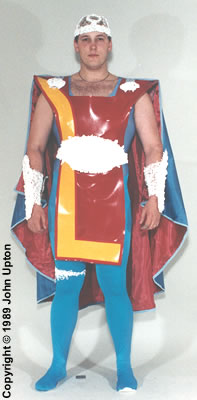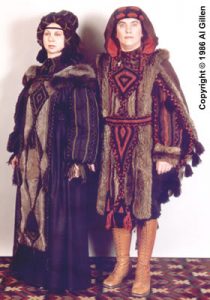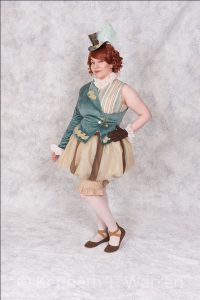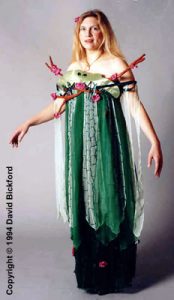CC07-FS-27: Muffle Robe
Competition Staff & Rules
Staff:
- Futuristic Fashion Folio Directors: Steve Gill & Patti Mercier Gill (Paczolt)*
- Future Fashion Show: Patti Mercier Gill (Paczolt)*
- Master of Ceremonies (In): Janet Wilson Anderson
- Master of Ceremonies (Out): Gary Anderson*
- Presentation Judges: (Folio): Kathryn Condon (Elms), D. Jeannette Holloman, Thomas Atkinson
Rules:
This year the Costume Con Future Fashion Show revolves around an alternate world scenario created by Peggy Kennedy. The planet Amphos has been given a rich and impressive culture – now, all we need is for you to show us what the Amphians wear!
Peggy has tried to describe Amphos well enough to give you a starting point for costumes. In a few cases, she has given some general characteristics of Amphian clothing, but these are not limiting, only guiding. If you have a better idea, use it.
There are design opportunities for all ages and body types. You can design work clothes or elaborate Festival wear, city outfits or country garments, spaceport uniforms or mercenary gear. You can create fashions for the native Amphians or for any of the many off-worlders who visit the planet each year. Outfits for the latter are, of course, not bound by Amphian cultural dictates, only by good taste!
So try the challenge of designing for the Amphos culture, or let your imagination run free with fashions for the spaceport crowd. Just about everybody (and everything) passes through there sooner or later!
Winning designs will be selected by a panel of judges appointed by the Directors. These winning designs will be published in a Future Fashion Folio, which will be mailed to all members of Costume Con Seven several months before the convention. Members may select one or more of the winning designs to make and model (or have someone else model) at the Future Fashion Show on Sunday afternoon, May 28, 1989. Of course, the designer wilt be given first refusal on the construction of his/her design.
Remember, artistic skill is not necessary — send an SASE to the Design Contest Address listed below and we will send you figures to draw on (thin, medium, heavy!). Or have an artistic friend translate your visions for you. So start designing now — the contest closes December 1, 1988.
DESIGN CONTEST RULES
1. All entries must relate in some way to the Amphos Scenario, either as Amphian seasonal fashions or as designs for off-worlders arriving via the spaceport.
2. All designs must be original ideas. You can draw your design on a traced figure or have someone else draw it, but the idea must not have been used before. If someone other than the designer is drawing the design, please give him or her credit on the back of your submission.
3. Your name and address must be marked clearly and legibly on the back of each entry submitted. If you wish to wear your design, should it win, please indicate this on the back as well.
4. Designs in color are always appreciated, but we must have a black and white copy of the submission for reproduction in the Fashion Folio. Please make sure that your black and white drawing is clean and will reproduce well. The color designs may be on any size paper, but you must submit the black and white copy on 8.5′ x 11′ (white) paper. Detail work may be on separate sheets.
5. All drawings should be either copies or any other clear, non-smudging reproduction. Please do not send us original art.
6. Number entries consecutively on the back in the upper right-hand corner. For example, if you submit four designs, number them: #1 of 4: #2 of 4; etc. Your black and white set should be labeled: copy # 1 of 4; copy #2 of 4; etc.
7. On the back of each entry, please put the preferred category you would like your design to be entered under, as well as either the season for which the entry is designed, or ‘spaceport’ for designs which are not seasonal in nature. Please include a short description of the design, the materials and colors used, and what kind of people or beings would wear it.
8. Some suggested categories for your entries are: work clothes; spaceport uniforms; leisure wear; ceremonial or religious outfits; Festival wear; mercenary gear; and whatever other category you want to dream up. It’s up to you! We will add categories for judging as they are needed.
9. Enter as many designs as you wish, as many times as you wish, and in as many different categories as you wish. ENTRIES MUST BE IN OUR HANDS BY DECEMBER 1, 1988 OR THEY WILL BE RETURNED UNOPENED. THIS IS ABSOLUTELY AND POSITIVELY THE ULTIMATE FINAL DEADLINE THAT WILL NOT BE EXTENDED BY SO MUCH AS A NANOSECOND. HONEST. ABSOLUTELY NO EXCEPTIONS. NO KIDDING !!!!!
10. You do not have to be a member of Costume Con 7 to enter the Fashion Design Contest. You must, however, be a member of CC7 if you wish to participate in the Fashion Show itself. This contest is open to any interested person.
11. Non-members who submit designs and who would like a copy of the Folio can obtain one by sending a $3.00 fee to cover publishing costs.
12. Your designs will be returned IF AND ONLY IF you request it, and enclose a large enough SASE with SUFFICIENT POSTAGE.
13. By submitting one or more designs to Costume Con 7, you agree to the non-profit use and publication of said design(s) by Costume Con 7, prior to and during the run of the convention. All rights will revert to the designer after the convention.
Please mail entries and all other correspondence to:
Future Fashion Design Contest c/o Patti Mercier Gill (Paczolt)*
[Address Removed]
Future Fashion Scenario
A PLANET BY DESIGN
The planet Amphos is a captured member of a G-type star system. Its orbit is eccentric, out of the plane of the ecliptic, and about 12 Earth years in length. At perigee, Amphos swings close enough to its sun to produce a (briefly) tropical climate, while at apogee the climate is rather worse than arctic. Thus, there is a long, extremely cold winter, a medium length spring of gradually increasing temperatures, a short, very hot summer, and a slowly cooling autumn which merges once again into winter. The gravity is about 0.7 Earth normal, as might be expected from its size — near that of Earth — and composition. Although Amphos has a magnetic field and thus presumably a core of nickel and iron, its mantle and crust are quite low in these and the heavier metals. As if in compensation, however, large and readily accessible deposits of exceptionally high grade aluminum and silicon oxides are scattered extensively about the planet’s surface.
The planet’s population is descended from humans who have adapted to the variable climatic conditions. The population is largely rural, but a sizeable city has grown up around the spaceport, which is open from early spring to the start of winter — about half the year. The spaceport accommodates the off-world trade in luxurious furs, exotic fruits and vegetables, distilled liqueurs, and ceramic artifacts, all of which command high prices throughout the Federation. Here, too, are concentrated the giant aluminum and silicon refineries, whose output — heavily in demand on more industrialized planets — constitutes Amphos’ principal export commodity, and whose byproducts are the major source of industrial pollution on this predominantly agrarian world.
As the planet warms in spring, both animals and humans gradually emerge from the almost comatose state, which has kept them alive during the coldest part of the winter. At this time, they are both thin and weak, having lived for the last (Earth) year or so on stored body fat. At the close of autumn were planted seeds of high-protein berries. These start to grow before the ground is fully thawed, and are ready to eat when hibernation is over. The orgiastic Spring Festival, which celebrates the return of the Sun and of life is held a few months later. It is principally during this Festival that the next generation is conceived, so that each group of children is almost identical in age. Actually, the people of Amphos are sexually active for most of the year, but the women are only fertile during the Spring.
The Festival lasts for 10 days, and during its course people visit one another’s villages or the city. The resulting interbreeding tends to reduce genetic anomalies. As in certain Earth species, the fertilized ova are kept viable within the mother’s body for a variable period. They only start to develop when a sufficiently good state of nutrition is attained. Young of all species arrive in multiple births of two to six, three being the usual number.
During spring and early summer people live mostly out-of-doors, are occupied with production of food and of offspring, and become lean and muscular from the labors of cultivating the land and preparing food stores for winter (in the country) or of construction and repair of facilities (in the city). Work is assigned by talent and strength, not by sex.
Towards the end of summer and the beginning of fall, metabolism changes so that fat may be stored against the coming cold. The fat serves both as caloric reserve and as insulation, so is evenly distributed about the body. By the time winter really sets in, individuals weigh twice or more what they did in summer. Partly because of the lighter gravity, the People’s bodies do not sag with the increased fat, but become generally rounder and buoyant.
As spring is a time of physical celebration, so late fall and early winter are times of intellectual activity. Plays, poetry, recitation, music, occupy the adults and give example to the children.
As the cold encroaches and outdoor life becomes less and less pleasant or even possible, the people gradually retire into their underground communal winter dwellings. The children born that summer are now 3 – 4 Earth years old. This retirement provides the perfect opportunity to start their schooling, and by the time of hibernation the younger ones have learned to read and write, while the children from the previous year have advanced their education. During the winter, these second-year children will reach sexual maturity and awaken to take part in the next Spring Festival.
Fashions in clothing are part of this yearly cycle. In early spring the clothing tends to be warm and unshaped, to cover thin and sagging bodies and to protect against the cool winds.
As the weather warms and bodies harden, less and less is worn, both because clothing is no longer needed and because the best endowed like to display their new firmness and muscularity. At the height of summer, men and women alike may wear little more than a cache-sexe. This includes pregnant women, whose bellies swell proudly above the tiny garment for all to see and delight in. This clothing, as well as the broad brimmed hat worn against the sun’s heat, are covered with elaborately decorated plaques of ceramics and of wood. The wood is used with unusual effect, since the& climatic changes produce intricate and fascinating grains. Among the Amphians, ceramic has been raised to a high art and — by tradition not yet impacted by galactic trade — substitutes for the previously scarce metals in both practical and decorative uses.
Autumn is the time for truly elaborate clothing. The crops are stored; there is time and energy for crafts, and the winter weight gain has only just started. The Harvest Festival brings out the ultimate in wardrobe elegance. City fashions reflect the rural traditions, with additions from off-world trade or from the local technology.
Animals on Amphos follow a life cycle similar to that of the humans. When the Freeze commences, herds are culled of those beasts least likely to survive the winter. Their meat is placed in special lockers which connect to the cold of the outside and their hides are cured. The clothing made from the furs are particularly sumptuous, as by this time of the year all animals including bovines are covered with thick soft fur. Even some of the humans grow a sort of short fur which falls out when the climate warms again. Winter garments are loose and simple in cut, being made of thick cloth lined with fur, or entirely of fur both inside and out.
Head coverings are often after the pattern of those worn in old Russia and frequently come down in a cape over the shoulders.
The society is matriarchal, a natural result of not knowing who the father (or fathers) of a set of children might be. The Amphian religion resembles a mix of nature worship and Zoro-astrianism, with a female equivalent of Ahura Mazda. They believe in reincarnation after a period of repentance in a Limbo beside which Niflheim seems warm. There are three major religious festivals: the Spring Orgy, the Harvest Festival, and the Ritual of Farewell, just prior to hibernation.
Amphians seldom die during the period from spring though the start of winter except by accident. The usual way of (temporarily) leaving the world is simply a failure to emerge from the semi-coma of hibernation. Without the resources to make the metabolic changes needed for revival, the person sinks into a true coma and dies as the earth thaws. The bodies are buried in the fields as part of the Spring Festival rites to disintegrate and contribute to new life. Just before retirement for hibernation, there is held a solemn rite where all say goodbye to one another, not knowing whom they will greet come spring.
Major wars are unknown, probably because of the futility of consolidating conquests during the winter isolation. The closest the Amphians have to wars are raids by outcasts seeking shelter from the killing cold. Off-worlders sometimes hire in as mercenaries at this time.
All off-worlders are welcomed at the Harvest Festival, but only humans are permitted at the Spring Orgy (for genetic reasons), and no strangers at all may attend the Rites of Farewell.
© 1988 by Margaret W. [Peggy] Kennedy*




